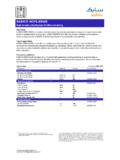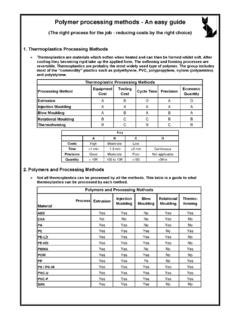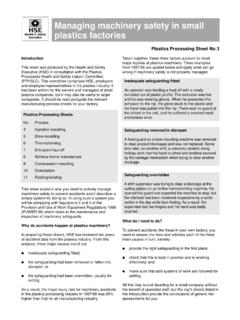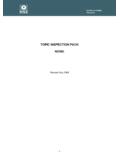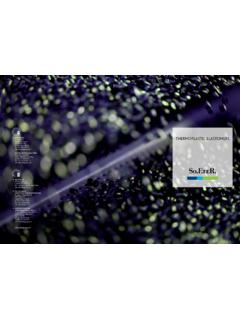Transcription of Controlling fume during plastics processing PPS13
1 1 of 4 pagesHealth and Safety ExecutiveHealth and Safety ExecutivePlastics processing Sheet No 13 (Revision 1)HSE information sheetControlling fume during plastics processingIntroductionThis information sheet is for anyone with health and safety responsibilities in plastics manufacture. It provides guidance on how to minimise and control plastics fume during moulding, extrusion and similar processes. It emphasises the need to reduce fume formation by maintaining plant and following recommended processing parameters such as process temperature and residence/dwell this guidance will help you ensure the prevention and adequate control of the respiratory and other toxic hazards that plastics processing can produce. These can include respiratory sensitisers, irritants and melt temperatures or residence/dwell times are key factors in Controlling fume . Unexpected fume problems can result if the substances contained in the material being processed are not known.
2 This can happen when new material is used or there is unintentional substitution, undisclosed grade change, impurities guidance does not deal with polyurethane moulding involving the reaction of isocyanates, or with styrene released during fibre-reinforced laminating. Health hazards plastics are usually processed as pellets, granules or powders. These include additives such as fillers, pigments, fire retardants and stabilisers, depending upon requirements. plastics fume , produced when the material is heated in processing , can include respiratory sensitisers, irritants and carcinogens. The exact composition of any fume varies. Immediate effects may include severe irritation to the eyes, nose and lungs. In some cases, the effects can be long-term and 1 gives examples of commonly processed plastics and some of the constituents detected in fume when they were heated above their recommended upper process 1 Examples of commonly processed plastics and constituents in fumePlasticConstituents in fumePVC Hydrogen chloride Fire-retarded ABS Styrene, phenol, butadiene Polypropylene Formaldehyde, acrolein, acetoneAcetals Formaldehyde Polyethylene (low density) Butane, other alkanes, alkenesPolystyrene Styrene, aldehydesControlling exposure to plastics fumeFume production is influenced by: the material being processed, including recommended temperature ranges and residence/dwell times; operating procedures, including purging; the reliability of temperature control; and machine/screw checklist If you take all the actions in the following checklist, you will minimise the risk of fume being produced.
3 Any remaining health risks will require appropriate assessment and action in accordance with COSHH ( ).Information on the material Obtain the safety data sheet (SDS) (see ) from the supplier/distributor for the particular formulation. Make sure that it includes all the information needed on: correct processing temperature; degradation products; any additives and their possible effects on fume of 4 pagesHealth and Safety Executive Check the supplier has a system for telling you of changes to information in SDSs. Review and update records and procedures when the information changes. Have accurate information on the residence time in the barrel of this formulation of the polymer at this processing time as well as temperature is critical in preventing fume production. For example, one grade of acetal processed at 240 C has a safe residence time of only 7 minutes; at 205 C it is 20 Identify and mark all virgin and regrind materials clearly so that the wrong material/grade can t be used by mistake.
4 Give machine operators all the relevant processing data (temperature, residence time, changes from previous formulation etc). Train operators in the correct ways to: purge; deal with blockages and cleaning; ensure nozzles seat correctly; handle alarm conditions or moulding problems which cause a halt in processing and follow emergency procedures (eg when processing heat-sensitive materials). Purging with purging compound should be done at low speed and pressure. In some cases, purged material will self-heat on contact with air and should be immersed into cold water as soon as possible. Burning out nozzles, blocked dies, injectors, material transfer valves, screen filter breaker plates and burning off solidified material should only be done under extraction, using pyrolysis units, or by other methods which prevent fume should seat correctly against sprue bushes to prevent leakage during moulding.
5 Handling alarm conditions or moulding problems is especially important when processing heat-sensitive materials (eg acetals and PVC).See the British plastics Federation s Safety guidance on the guarding and use of injection moulding machines in the plastics and rubber industries for more information on purging, dealing with blockages and control Use equipment and systems for checking that material is being processed at the right temperature. Ensure that the right thermocouples and heater bands are selected and properly fitted. Older machines may not have proportional, proportional-type (PD or PID), or PC-controlled heating. Cycling effects with on/off controllers make heater band failure, and therefore fume problems, more likely. Check for visual signs of damage to thermocouples and leads. Procedures should be in place for regular inspection. Check that machine alarms and cut -outs are working including those on ancillary equipment such as dryers.
6 Regular inspection procedures should be taking place: heater band failure can be just as serious as an overheat, as it increases the residence time. Reduce the risk of material degradation when the machine is idling with the barrel full of material at processing temperature (eg by lowering the barrel temperature and/or keeping material moving through the unit).Heat-sensitive material (eg acetal and PVC) will begin to degrade quickly if held at processing Machines should be kept clean. Spilled materials on the outside of the barrel can heat up and produce fume . Barrels/screws should be adequately cleaned after any incident when material has degraded in the barrel. Traces of degraded material can cause rapid degradation of newly introduced maintenance Check for screw wear, implementing a checking system where necessary (see maintaining control measures). Inadequate flight depth or screw diameter caused by wear can reduce pressure and output therefore increase residence time.
7 Refurbishing the heater system is advised if you run machines over ten years old with simple on/off controllers. This is an effective way of reducing failures that may cause fume problems. Identify and implement, depending on the age and sophistication of the machine, any appropriate additional checks to reduce the risk of producing harmful amounts of plastic fume . Ventilation Ensure processes are well ventilated in all cases. Provide local exhaust ventilation (LEV) wherever material manufacturers recommend it and your own assessment confirms it is required. 3 of 4 pagesHealth and Safety ExecutiveFollowing the processing parameters, plant maintenance and general ventilation will not control fume in all circumstances. Examples of processes/activities where LEV is likely to be required are: recycling mixed grades of polymer at pelletiser units; bag making at sealing heads where film regularly sticks and overheats; blown film lines with internal bubble cooling where the fume -laden air needs to be ducted outside; burning out blocked dies and nozzles; older machines where process controls are less control measures Once your control measures are in place, you need to maintain them using the following checks and recommended frequencies, so they continue to provide good control all the time.
8 Regular inspection procedures should be taking place. These can be amended and refined in the light of or at material/grade change Housekeeping material storage areas are clearly marked, and heater bands/barrel units are free of spilled material. Operators have written information giving clear specifications and processing conditions for materials being run. Machine fault alarms (over- and under-temperature, where fitted) are working. The melt temperature has been verified. The local exhaust and general ventilation fans are switched on and working. Monthly Heater bands are in good condition. Where not in use, heater bands are being stored in dry, secure areas to prevent water ingress and mechanical damage. Annually Check the polymer formulations you use have remained similar to those considered in your original risk assessment and if there have been changes amend your records and procedures as necessary.
9 Review operator training and instruction procedures (eg for purging, freeing blockages) identify whether they are still suitable, correct and being correctly followed and, if necessary, reissue or revise them. Identify whether you need to check for screw flight or barrel wear. Check/calibrate temperature controllers. Have the LEV thoroughly examined (at least 14-monthly) and keep a record of Set out clearly in writing the procedures to be adopted. This will help you to ensure the actions are understood correctly and carried out exactly as you intended. Train operators to work to the laid-down procedures, and make sure supervisors regularly check they are being complied procedures Provide emergency procedures when processing heat-sensitive materials (eg acetals and PVC). processing acetals can give rise to a blow-out , due to rapid degradation in the barrel and emergency procedures are needed since formaldehyde may be produced.
10 Make sure any emergency procedures are clearly explained and practised by all who may need to use them. Emergency procedures and rehearsals should include evacuation of the area(s) likely to be readingGeneral COSHH advice: COSHH assessment: Control measures: Safety data sheets: Control of substances hazardous to health (Fifth edition). The Control of Substances Hazardous to Health Regulations 2002 (as amended). Approved Code of Practice and guidance L5 (Fifth edition) HSE Books 2005 ISBN 978 0 7176 2981 7 Safety guidance on the guarding and use of injection moulding machines in the plastics and rubber industries 238/3 BPF 1991 Available from British plastics Federation, 6 Bath Place, Rivington Street, London EC2A 3JE Tel: 020 7457 5000 fume and temperature control in plastics processing : Practicality of preventing the evolution of plastic process fume through temperature control CRR231 HSE Books 1999 ISBN 0 7176 2475 7 4 of 4 pagesHealth and Safety ExecutivePublished by the Health and Safety Executive PPIS13(rev1) 12/15 Further informationFor information about health and safety, or to report inconsistencies or inaccuracies in this guidance, visit You can view HSE guidance online and order priced publications from the website.










